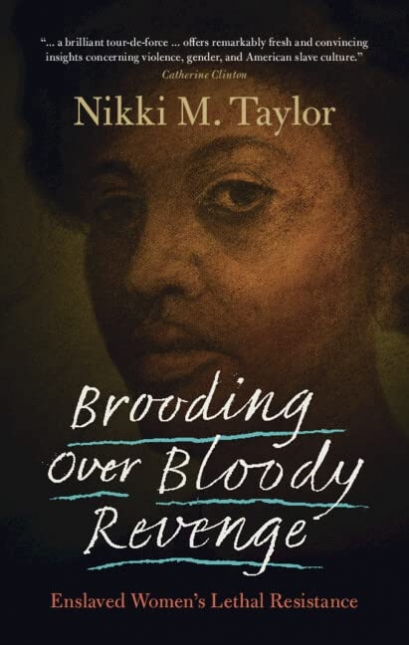Brooding Over Bloody Revenge: Enslaved Women’s Lethal Resistance
- By Nikki M. Taylor
- Cambridge University Press
- 250 pp.
- Reviewed by Peggy Kurkowski
- September 12, 2023
A scorching, stunning look at private revolts against bondage.

A groundbreaking study turns gendered assumptions about the experiences of enslaved women on its head in the aptly titled Brooding Over Bloody Revenge by Howard University professor Nikki M. Taylor.
Throughout the American colonial and antebellum eras, enslaved women who resisted their cruel circumstances did so covertly and nonviolently, or so the story goes. But the truth is radically different, claims Taylor, who, in this slim volume, rectifies hundreds of years of “archival silencing” to reveal the ultimate retribution some of these women inflicted upon their masters. While violent resistance was not a preferred tactic among most enslaved women, the fact it happened at all “despite the constant surveillance and repression women endured” is what makes these actions remarkable, says the author.
Through a series of compelling — and often gruesome — case studies, Taylor frames the women’s experiences through the lens of what she calls a “Black feminist practice of justice,” an extension of a philosophy that, at its root, demands “fairness, decency, justness, and humane treatment.” When all other forms of nonviolent resistance failed to alleviate their abuse and suffering, some enslaved women resorted to murdering their owners — an act Taylor is careful to define as not just killing but rather “slave resistance” itself.
Spanning the entire U.S. slave era — and ranging from the early colonies on the Eastern Seaboard and the anti-slavery states of Pennsylvania and New York to the upper South and Texas — Taylor’s case studies include the intimate and painful life experiences of seven women and their accomplices. Delivered chronologically, each is riveting and written like the true-crime narratives they are.
The first recounts the story of Phillis and Phoebe in 1755 Massachusetts, two enslaved women working together to kill their wicked owner through a regimen of slow arsenic poisoning over six years. After accidentally delivering too much arsenic in one dose to the despotic Captain Codman, the women were discovered and charged with murder. (Shockingly, while Phoebe avoided conviction, Phillis was burned at the stake for the crime.)
Other cases reveal plots that differed in the mode of killing (beating, strangulation, drowning) and in the intended targets (including slaveowners’ children), and that unfolded amid varying legal and social contexts. Yet Taylor makes clear her subjects were all rightly accused of murder, having premeditated how and when their enslavers would die. These women “articulated a reason for using lethal resistance,” and Taylor argues persuasively that given what they endured, “lethal force is a legitimate response to the abuse, violence, and indignity of enslavement.” She also addresses the patriarchal idea “even within Black community/ies” that violence is understood “to be the prerogative of Black men.” Her carefully selected cases forcefully rebuke this assumption.
More than just isolated studies, the book contains a wealth of regional history pertaining to slavery in the areas where the crimes occurred. Taylor also weaves in the glaring hypocrisies and outright injustices suffered by enslaved women under the United States judicial system, which she terms a “burlesque.” Slaveowners “wielded all society’s power and held the keys” to this system that crushed and disenfranchised these women under the intersection of “patriarchy, white supremacy, and wealth.” Taylor’s deep dive into state laws and trial records uncovers the absolute vulnerability of Black people, who had “no protections under the law” and were often prohibited from testifying in court in their own defense.
While not an exhaustive catalog of every instance of lethal resistance on the part of enslaved women, the book achieves Taylor’s goal of building a “blueprint” for future research into this woefully understudied aspect of slavery. Buttressed with reams of powerful primary source material interpreted through the author’s penetrating lens of Black feminism, Brooding Over Bloody Revenge is a savagely brilliant look at oppressed women forced to seize justice for themselves.
Peggy Kurkowski is a professional copywriter for a higher-education IT nonprofit association by day and major history nerd at night. She writes for multiple book review publications, including Publishers Weekly, Library Journal, BookBrowse Review, Historical Novels Review, Open Letters Review, Shelf Awareness, and the Independent. She hosts her own YouTube channel, “The History Shelf,” where she features and reviews history books (new and old), as well as a variety of fiction. She lives in Colorado with her partner (quite possibly the funniest Irish woman alive) and four adorable, ridiculous dogs.

